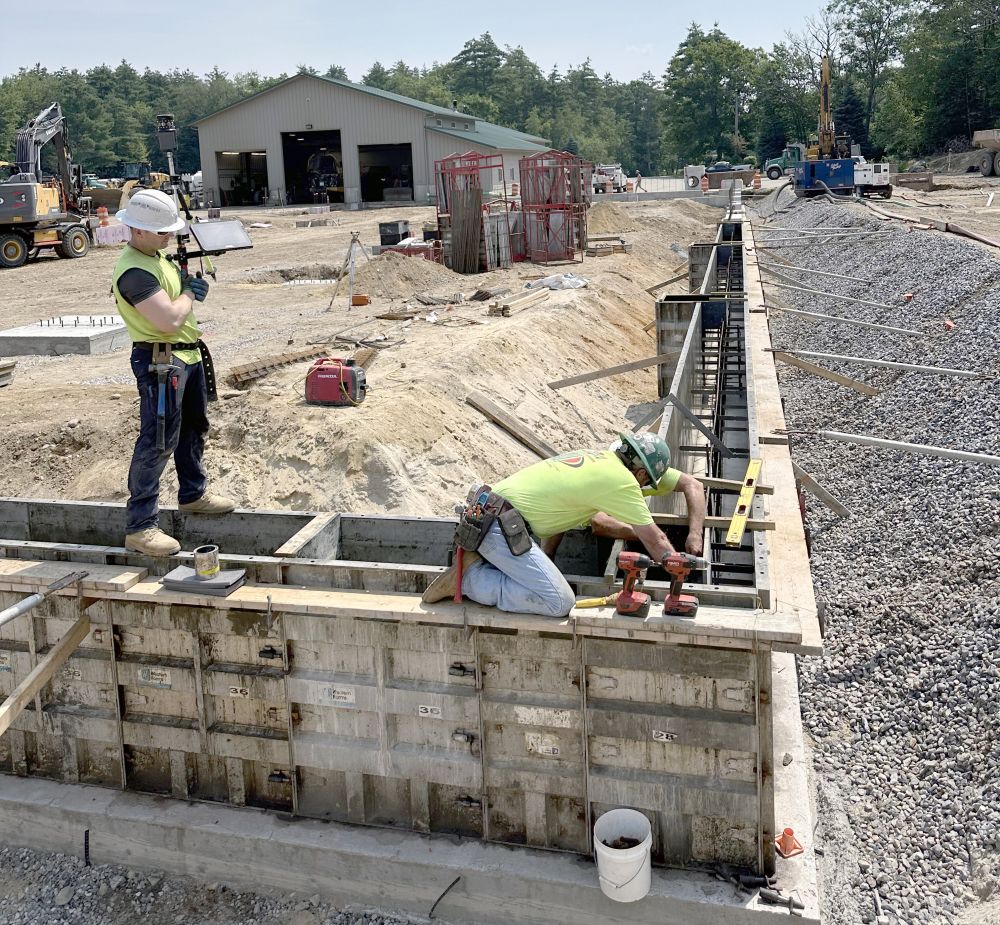 Southern NH Poured Concrete Construction employees install anchor bolts for structural steel for an addition at a Severino Trucking building. (Courtesy of Southern NH Poured Concrete Construction)
Southern NH Poured Concrete Construction employees install anchor bolts for structural steel for an addition at a Severino Trucking building. (Courtesy of Southern NH Poured Concrete Construction)
New Hampshire subcontractors—or specialty contractors as they’re also referred to—include thousands of plumbers, site workers, electricians, roofers, painters, drywallers and many more skilled professionals. They are the lifeblood of the construction industry and unfortunately, says Josh Reap, president and CEO for the Association of Builders and Contractors (ABC) for the NH and Vermont chapter, there aren’t enough of them.
Reap says the labor shortage is a big concern across all fields of construction work. “Ten years ago, the average worker on a construction team was in their mid-to-late 40s and now they’re in their mid-to-late 50s,” Reap says, adding that many of are looking to retire. “Finding workers was a challenge then, and today it’s a crisis.”
According to ABC Chief Economist Anirban Basu, in an ABC newsletter in February, nearly one in four construction workers are older than 55, and the number of skilled workers has grown at a much slower pace, or, in the case of certain occupations like carpenters, have declined.
The construction industry averaged more than 390,000 job openings per month in 2022, the highest level on record, and the industry unemployment rate of 4.6% in 2022 was the second lowest on record, behind the 4.5% unemployment rate in 2019.
According to ABC, the construction industry will need to attract an estimated 546,000 additional workers on top of the normal pace of hiring in 2023 to meet the demand for labor.
New Hampshire’s Department of Employment Security’s (NHDES) Job Outlook and Locator for 2020 to 2030 shows rising demand for specialty trade contractors. Reap says much of this growth in NH is due to multi-year, multi-phase projects like the Tuscan Village development in Salem as well as multifamily housing projects, data centers and health care facilities.
Projected growth rates for subcontractors between 2020 to 2030 range from 2.6% for concrete masons and finishers to 11.1% for electricians. Demand for roofers is expected to climb 6.8%, 7.1% for dry wall and ceiling tilers as well as plumbers, 7.3% for painters, and 10.1% for tile and stone setters.
Finding the workers to fill those positions, Reap says, “will depend in large part on the continued efforts to educate young people about the many opportunities that exist in the trades.”
The Search for Skilled Workers
Matthew Wheaton, executive vice president at DEW Construction in Manchester, says some regions, especially rural areas, have a limited pool of subcontractors. DEW serves a range of clients across NH, Vermont, Maine and Massachusetts. “There are pockets of subcontractors that are available in these areas,” he says, adding that DEW needed to use a NH-based company recently for a project in Burlington. “In smaller regions, there are fewer subcontractors to choose from. For large projects, we sometimes need to pull from regions farther away.”
Dale White, owner of the site excavation company Leighton A. White in Milford, has been in business for 45 years. His company has 52 full- and part-time employees, and White says the reason his company has many part-time employees is he can’t find enough full-time personnel with the right skillsets. “The technicality of sitework has changed over the years because of automation,” White says, explaining that excavators need to have a high caliber of skill. “When we first started, you could meet someone downtown and they’d jump in to work. It was just brute labor, but that’s not the case today.”
White says he has had forklift operators interview for jobs, asking for a chance to work, and has had to turn them down because the technical precision involved in digging around high-tension electrical wires and high-pressure gas lines makes it too risky to hire someone without experience. “We need more internal training and ABC is doing some of this, but we can’t all do it. People need to start as a laborer and learn how the process works,” White says.
Robert Slater, president of Southern NH Poured Concrete Construction in Londonderry, says finding workers has been difficult at times. Over the last two years, fewer people have been choosing concrete as a career, he says. Southern NH Concrete has run three crews with 12 to 14 people in the past, but today runs a crew of nine. Slater blames large warehouse operations, like Amazon, for siphoning workers as well as the rise in jobs that offer remote work. “I’ve only hired one person this year,” he says, adding the company needs quality candidates. “We try to do the highest quality work every day because there’s no forgiveness with concrete and no going back.” That means maintaining a committed and skilled workforce. “Some people look at the work we do as a job, but we look at it as creating art. We look to do the best in the industry, and we pay well.”
To attract and retain employees, Southern NH Concrete also provides clothing, tools, as well as competitive wages, and Slater says family comes first. “We don’t over book ourselves; we work at a normal pace and enjoy the day,” he says. “If it’s a bad weather day, we go home and I pay the guys. We’re not running people into the ground.”
 Chad Lacasse, owner of Millwork Center, left, and Jake Cardente of Cardente Property Maintenance. (Courtesy of Millwork Center)
Chad Lacasse, owner of Millwork Center, left, and Jake Cardente of Cardente Property Maintenance. (Courtesy of Millwork Center)
Chad Lacasse, owner of Millwork Center in West Lebanon, sells high-end windows and doors throughout central Vermont, NH and upstate New York. Lacasse says Millwork Center had a full crew of installers in the past but has scaled back because of the tight workforce. “We’re trying to make sure we don’t overpromise and underdeliver,” he says, adding that he expects to be running an installation crew after the first of the year. Lacasse says it takes about four months to find a qualified candidate for the installation crew, which has four employees when in full operation. “We’re looking to hire here, but the labor pool is shallow at moment,” he says.
Most of Millwork Center’s business is selling to contractors and builders, and installation only makes up about 10% of business. Competing for workers with his own clients can be a problem. “If I’m installing for builders [that] I sell windows to, I run the risk of cannibalizing my customers’ employees,” he says.
Building a Trades Workforce
While the lack of employees is a problem, there is no lack of work. Contractors are turning work down because they have more than enough. “Today, it’s a specialty contractors dream out there,” Reap says, explaining the deluge of work allows contractors to name their price for many jobs and to turn down work they don’t want.
And in some cases, they are turning down work because they don’t have enough employees to create an additional crew. Many young people have chosen college over the trades in the past 25 years, Reap says, contributing to the labor shortage. What they don’t realize, he explains, is that the industry offers several opportunities for high-tech, high-wage jobs with minimal travel time.
“We need to generate interest in the trades for people to realize there’s a living to be made here,” Wheaton says. “Anything the industry can do to support trades the better. They’re starving for help.”
ABC represents 270 construction companies across NH and Vermont by providing networking opportunities, legislative advocacy and helping contractors develop their workforce. One of ABC’s initiatives, I Build NH, connects construction companies with educators and young people who want to explore career opportunities in the trades. “That’s going remarkably well,” Reap says, helping to attract more candidates to the trades out of high school or to pursue a trades program at NH’s community colleges.
In 2021, ABC partnered with the NH Home Builders Association, ApprenticeshipNH and Manchester Community College to create a registered carpentry apprenticeship program approved by the U.S. Department of Labor. The program is desperately needed to help address the shortage of carpenters in the state. ABC and NH Home Builders Association worked together to develop standards and a curriculum. Apprentices will receive 6,000 hours of on-the-job learning and 455 hours of classroom training at Manchester Community College over three years, all while earning pay. The curriculum will also include modules in plumbing, HVAC, electrical, masonry and estimating.
At the end of September, ABC partnered with Construction Career Days at the 4H Youth fairgrounds in New Boston where thousands of students had a chance to speak with employers about career opportunities in the trades. “People don’t always understand you can start out at $55,000 to $65,000 a year or more in many fields. Iron workers can write their own tickets,” Reap says.
White, who is part of ABC as well as the Association of General Contractors, says efforts to attract younger people into the construction industry are better than ever before. “We hope we’re going to see the results soon,” he says.
